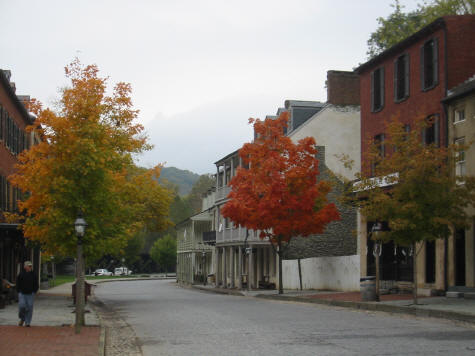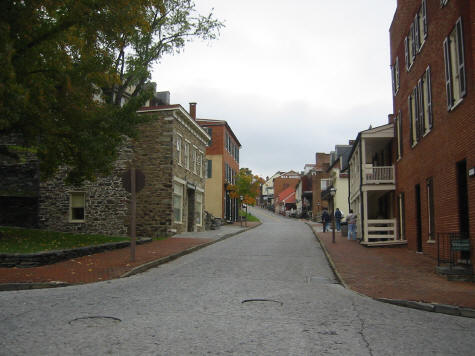October 22
Harpers Ferry
We slept in till 8, then grabbed breakfast in the hotel restaurant (FREE breakfast? How gauche. This is the CLARION.), and hit the road. Today’s goal was Harpers Ferry, Virginia. I had forgotten the charger cord for my PDA, so we got directions to the closest Radio Shack, and planned our route around that. When we arrived we parked at the Visitors Center and took the shuttle down into the town. Harpers Ferry sits on a point at the confluence of the Shenandoah and Potomac rivers, and at the northern end of the Shenandoah Valley, making it an important industrial and transportation hub, as well as a militarily strategic location. Meriwether Lewis came here in 1803 to outfit the Corps of Discovery. It was here that abolitionist John Brown seized the Federal Arsenal in October of 1859, with plans to arm southern slaves with the weapons he captured and lead a rebellion. The town changed hands several times during the Civil War, and much of its gun-making equipment was taken south into the heart of the Confederacy. W.E.B. DuBois’ Niagara Movement, the first major American civil rights organization and the predecessor of the NAACP, met here in 1905. So there is plenty to do and see here. It is also the best-preserved city Virginia, which is why Ted Turner chose it for the filming of Gods and Generals. The town is very pretty, and we walked around in shops and museums for several hours.
|
|
|
|
|
|
Standing at the river confluence, I saw a guy making a panoramic photo, so I jokingly asked him to e-mail it to me. He asked for my email address, and this is the result!
.jpg)
Photo compliments of Baan Alsinawi.
Harpers Ferry is a beautiful little town, made all the more captivating by the brilliant fall colors. I told Eric that I would have to bring Lana back here some day.
We left around 1, headed to Manassas. As usual, I wanted to take little squiggly roads, so I mapped out a roundabout route. We took 340 for a short distance, looking for 671, which I missed and we had to double back to. From there, Hwy 9 took us to 704, a wonderful little road, to US 15 (the same road that runs through Gettysburg). We noticed that traffic was getting heavy on 15…lots of folks were trying to get out of DC for the weekend. We took a wrong turn looking for the visitor center and had to turn around and sit in traffic for a while to get back to our turn. We got straightened out and ran the last mile or two to the turn-in. By now traffic in the opposing lane, coming out of DC, was bumper to bumper. But as we came up a rise, there was a long break in traffic. The opposing lane was clear for at least a quarter mile. The next car that we came up on was a Ford Expedition. It was stopped, and it’s driver, a woman, had her head laid back on the headrest, with her mouth open and eyes closed. Behind her, traffic was backed up as far as we could see. Her vehicle was so big that no one behind her could see that the road ahead was clear. We didn’t know if she was asleep, passed out, dead, or what. We turned into the Visitor Center parking lot, took off our helmets, and confirmed that we had both seen the same thing. We were about to saddle back up and go check on her when traffic started moving. I guess she woke up.
It was about 3PM when we arrived, so we caught a quick movie in the Visitors Center, then walked the battlefield and looked at the displays. There were actually two battles here, but most of the information was about the first one, July 1861, the first battle of the Civil War. At that time, most people thought that the war would be short lived. As the armies arrayed for this battle, civilians from Washington came out in their buggies with their children and picnic lunches to watch the battle. Their innocence was quickly lost. Union General McDowell marched 35,000 raw recruits on 90-day enlistments out to meet the southerners, many of whom were defending their native Virginia from invaders. Writings from the time tell of the green soldiers taking time to pick blackberries as they marched…just a walk in the summer woods. At the end of the day, 900 men lay dead on the field, as the narrow roads back to Washington became choked with terrified civilians and soldiers fleeing to safety. It was on this field that Thomas J. Jackson earned his nickname “Stonewall” as he formed his troops on the reverse side of Henry Hill and refused to budge as shot and shell flew around him.
|
Rickett's Battery, Union. Captured by 7th Georgia.
|
Jackson's Battery, crest of Henry Hill.
|
|
Wagon path taken by Jackson's troops.
|
Jackson's troop position. Eric is where the Union soldiers crested the hill.
|
|
"There stands Jackson like a stone wall, rally behind the Virginians" |
Thomas J. "Stonewall" Jackson |
The National Park Service has details of the two battles at Manassas at http://www.nps.gov/mana/home.htm.

We finished up at the park about 5 PM, and ran just a few miles south to I66, where there were plenty of hotels. It was amazing to turn out of the park, top a rise, and BOOM, there was a city! The park is only 25 miles from the heart of DC, and the urban sprawl runs right up to it’s southern edge. We took a room at a Fairfield Inn and had dinner at Cracker Barrel, which had a better steak than the Clarion last night, for about 1/3 the price.
Stats: 71 miles, moving average 40 MPH, overall average 27 MPH, maximum speed 70 MPH









